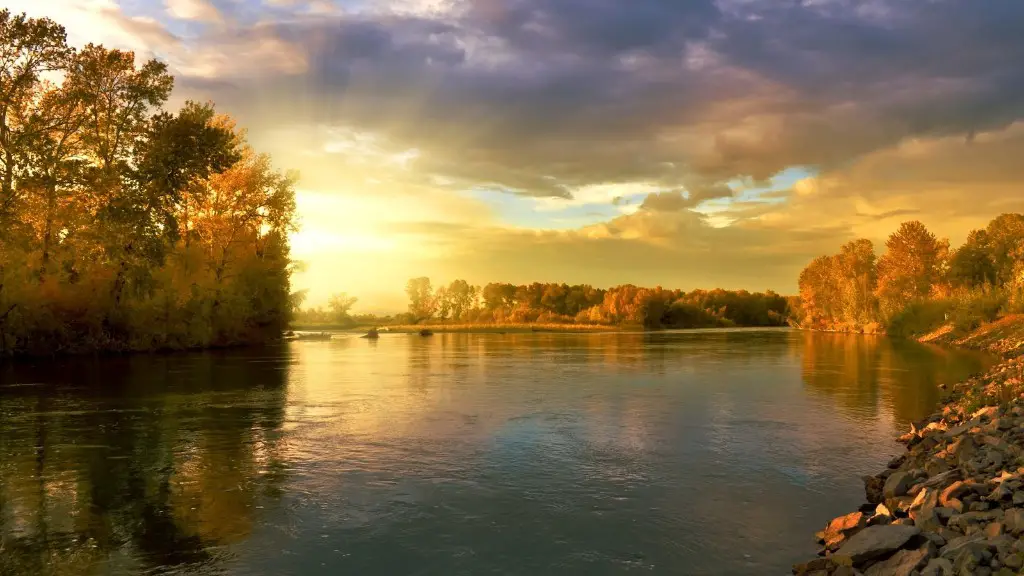Mississippi River: A brief overview
The Mississippi River is the second-longest river and chief river of the second-largest drainage system on the North American continent, second only to the Hudson Bay drainage system. It runs 3,734 kilometers (2,320 miles) from its source at Lake Itasca in Minnesota to the Gulf of Mexico. Along its path, the river traverses ten states including, Minnesota, Wisconsin, Iowa, Illinois, Missouri, Kentucky, Tennessee, Arkansas, Mississippi, and Louisiana. The Mississippi River is a key natural resource for navigation, commerce, and recreation throughout the Mississippi River drainage basin, with over 100 ports located on its course.
Did the Mississippi River Dry Up
The Mississippi River has experienced both record high and record low flows over its long-history. One particularly bad drought in 1988 caused levels to drop so low that parts of the river dried up. Low water levels in 1988 caused 18 locks and dams to be closed, and the Mississippi was completely blocked at one point near St. Louis. This affected navigation, business, and recreation opportunities in the region. Droughts of this severity don’t happen every year and tend to be localized and sporadic.
Today, the Mississippi River is, thankfully, in much better shape. In 2020, after flooding, the National Weather Service’s gauge at Vicksburg reached a historic high of 57.1 feet. This was the highest level in more than 70 years, exceeding the previous high, set in 1927, by more than two feet. Subsequently, the U.S. Army Corps of Engineers opened the floodway at Morganza to relieve the pressure.
This event serves to highlight both the importance, and the fragility, of the Mississippi River. For the people and industries that rely on the river, extreme weather and changing climates pose a serious threat. To mitigate these risks, the states of the river’s watershed have begun to implement measures that help reduce the strain on the river. This includes exploring more efficient methods of water management, investing in sustainable agriculture, and developing both flood protection and water preservation infrastructure.
Analysis of Situation
According to experts, the recent incident serves as a stark reminder of the potential for river levels to drop significantly. Although, it is unlikely that the Mississippi River will ever suffer from such severe drought conditions again in the foreseeable future, it is important to acknowledge the potential risks and take appropriate action. Unregulated activities such as extractive industries, wastewater disposal, and sand mining can cause severe disruption to the river ecosystem, leading to a degradation of water quality, which can significantly impact the livelihoods and economies of those who depend on the river.
Furthermore, the increasingly unpredictable climate of the region can cause further volatility in the river’s flow, potentially leading to shortages of water in the future. In order to prevent this, it is important to continue investment into sustainable water management measures, and to tackle climate change head-on. By doing so, we can ensure a healthy, vibrant future for the Mississippi River.
The Impact on River-Side Communities
The low river levels in 1988 had a direct effect on the communities that depend on the river. During the drought, towns and businesses along the Mississippi were forced to ration their water, and the river became too shallow for barges to navigate, leading to a drop in trade and the loss of jobs. The situation was so severe that, during the worst part of the drought, businesses in the region considered using tankers to transport goods along the Mississippi.
The effect of the drought on the river-side communities was not just economic. The drought also affected the lives of local people, with many facing water restrictions and limited access to recreational activities such as boating and fishing. Fortunately, the river returned to normal levels soon after the drought had passed, allowing life to return to normal. However, such incidents are a reminder of just how fragile a resource the Mississippi River can be.
Environmental Impact
The effects of the drought on the environment were also significant. The drought left the river vulnerable to increased runoff, and the quality of the water dropped as pollutants and sediment built up in the stagnant water. This impaired the health of the river ecosystem, leading to a decline in the number and diversity of fish, amphibians, and other aquatic creatures inhabiting the river.
In addition, the reduced flow of the river caused the water temperature to rise significantly, which had a devastating effect on the fish population. The excessive heat affected the reproductive and feeding cycles of the fish, leading to a population crash. Unfortunately, the consequences of this environmental damage can still be seen today, in the form of an impaired variety of fish species in the Mississippi, and a reduced population of them.
The Role of Human Activity
While weather plays an important role in feeding the river, human activities can also have an impact. Increased use of agrochemicals, such as fertilizers and pesticides, and decreased permeability of the soil due to land use changes are thought to contribute significantly to the river’s increasing load of sediments, nutrients and pollutants. These pollutants are then transported downstream, where they can have a devastating effect on the aquatic life and water quality of the river.
In addition, the over-extraction of groundwater for agricultural, industrial, and domestic uses can also have a serious effect on the river’s flow. By reducing the amount of runoff and seepage into the river, groundwater extraction can contribute to droughts, further reducing the river’s flow.
Possible Solutions
In order to mitigate the risks associated with the Mississippi River, it is important to focus on both improving current practices and developing new technologies and initiatives that can help protect the health of the river. Improved wastewater and agricultural runoff management have great potential to reduce the amount of pollutants in the river, and to improve the water quality.
At the same time, investment in renewable energy sources could minimize the strain on the river, while providing significant economic opportunities in the region. In addition, conservation of the river’s natural habitats could also help support increased populations of fish, amphibians, and other wildlife in the area.
Opportunities for Conservation
By focusing on improved water management, sustainable development and conservation, the Mississippi River can be preserved for future generations. The river is an invaluable asset, providing vital resources and supporting countless businesses and recreational activities throughout the watershed. It is only with the proper care and attention that this critical resource can be maintained for the benefit of all.
Agricultural Practices
Changing agricultural practices have had a significant impact on the Mississippi River and its tributaries. Unsustainable farming practices, such as fertilization, have been linked to increased levels of nitrogen, phosphorous and other pollutants in the river. These pollutants are known to damage river ecosystems, leading to a decline in the health of aquatic life.
In order to reduce the impact of agricultural practices on river health, it is important to invest in sustainable farming methods, such as crop rotation, improved soil conservation, and integrated pest management. In addition, more efficient irrigation practices, combined with investment in renewable energy sources, can help reduce the strain on the Mississippi River, while also providing economic opportunities in the region.
Urban Development Challenges
Urban development in the Mississippi River watershed has also had a detrimental effect on the health of the river. The vast array of impervious surfaces created by development limits the flow of water into the river, reducing its capacity to handle runoff and pollutants.
In order to reduce the impact of development, it is important to focus on using green infrastructure, such as permeable surfaces and rain gardens, in urban areas. This will help to reduce runoff and improve the water quality of the river. In addition, investing in renewable energy sources can help reduce the strain on the River while providing significant economic returns in the region.
Flood Protection
Extreme weather events, such as floods, can cause significant damage to the environment, economy, and infrastructure of the Mississippi River. In order to protect the people and industries of the river’s watershed, it is important to invest in infrastructure such as dams and levees that can help to reduce the risk of flooding.
At the same time, it is important to recognize the potential benefits of controlled flooding. Such events can help to replenish soils, enhancing agricultural productivity and water infiltration capacity. In addition, controlled flooding can also provide important services such as fish habitat, recreation, and nutrient and sediment transport.
Conclusion
In conclusion, it is clear that the Mississippi River is a highly valuable and vulnerable resource that needs to be protected for the benefit of all. Through improved management, conservation, and flood protection measures, we can ensure a healthy future for the Mississippi River and its watershed.





